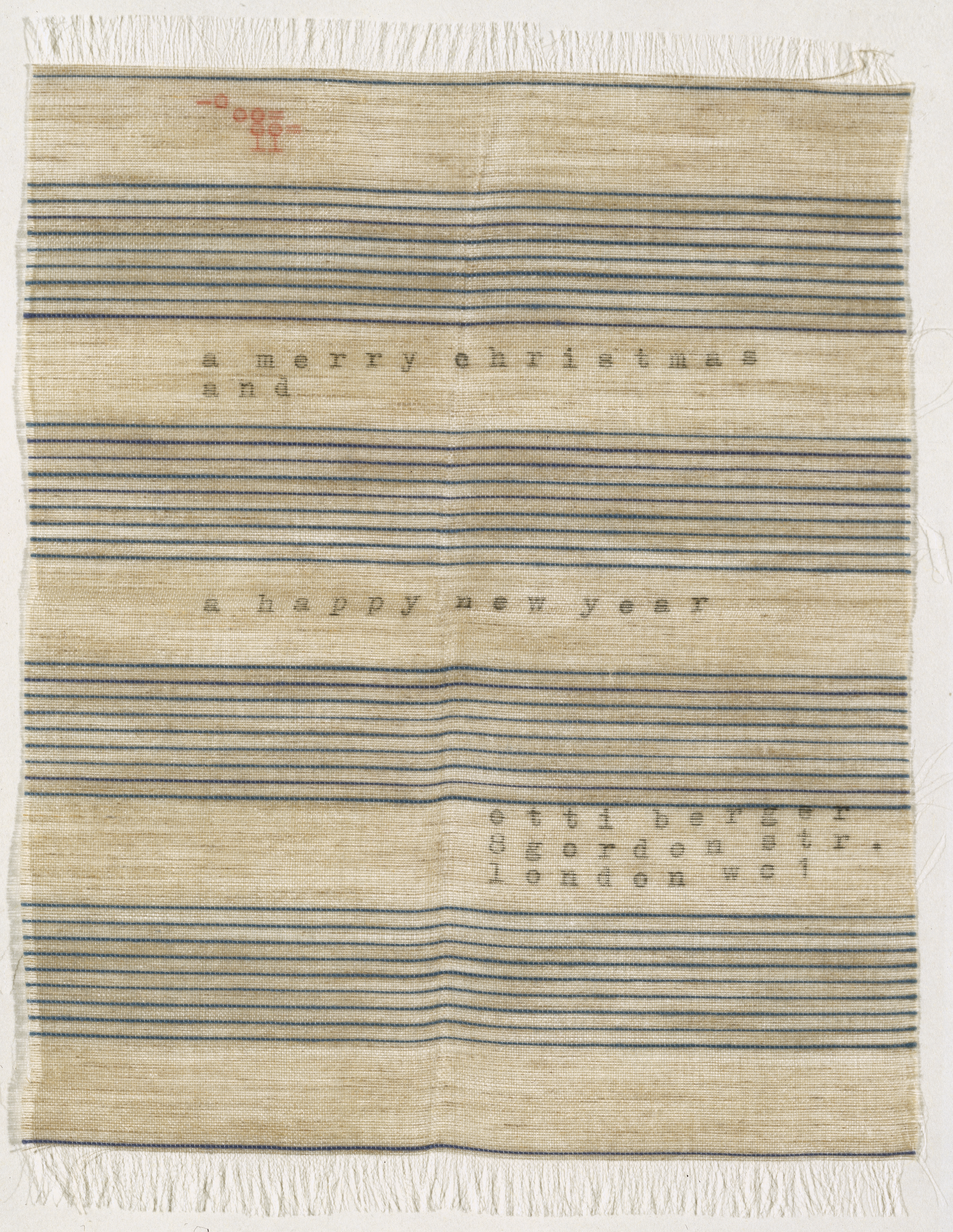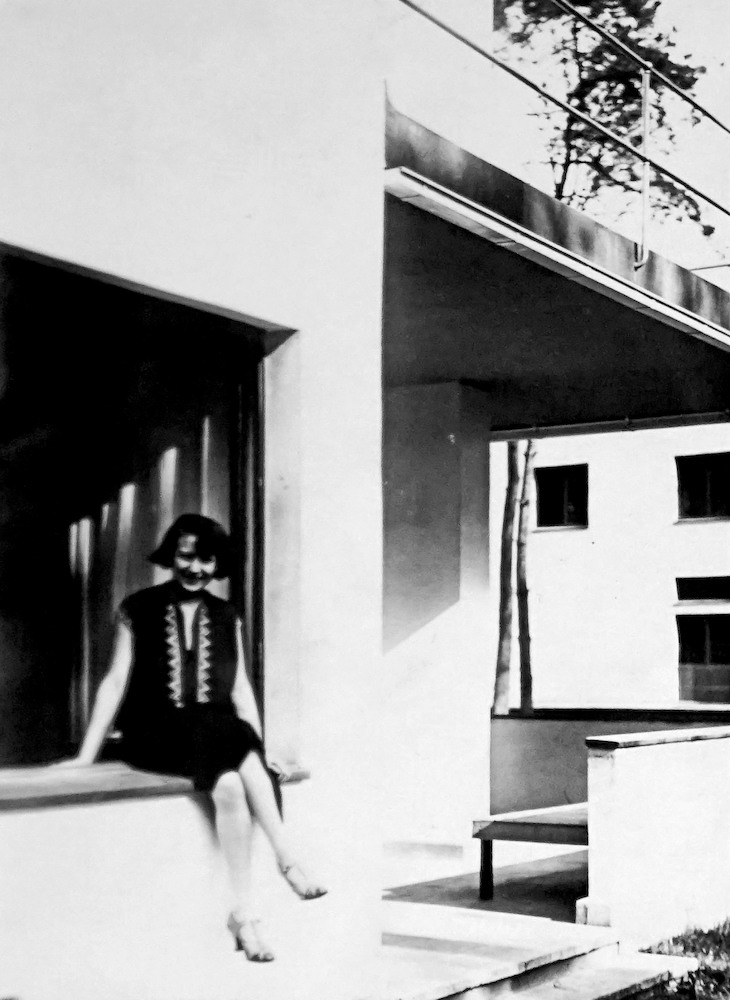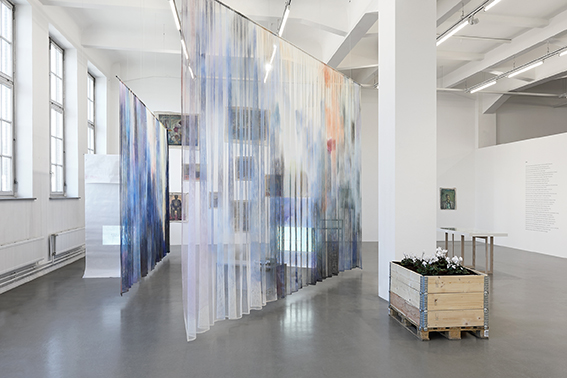Archive
Otti Berger
- Otti
- Berger
Otilija Ester Berger
- 04-10-1898
- Zmajevac-Baranja (Austro-Hungarian Empire (now Croatia))
- 1944
- Auschwitz concentration camp (Poland)
- Textile DesignerWeaver
The textile designer and weaver Otti Berger lived in exile in London in 1937/38, where she sought to open up a new field of activity.
Word Count: 24

Otti Berger, Christmas and New Year’s Card, 1937, typewriting on silk (Harvard Art Museums/Busch-Reisinger Museum, gift of Lydia Dorner in memory of Dr. Alexander Dorner, Accession Number BR58.166, © President and Fellows of Harvard College). 
T. Lux Feininger, Otti Berger, sitting, in window, c. 1930 (Dessau © The Estate of T. Lux Feininger, repro: www.kunst-archive.net). 
Otti Berger, Translucent dividing curtain, Haus Schminke, Löbau, 1933, photo: Ernst Nipkow (Harvard Art Museums/Busch-Reisinger Museum, Gift of Mrs. Walter Gropius, Accession Number BR52.331, © President and Fellows of Harvard College). 
Otti Berger, Burdale, textile design for Helios Ltd., Bolton, 1938 (Courtesy of the Whitworth, The University of Manchester, Image © Michael Pollard). 
Judith Raum, Day by Idle Day / In den Tag hinein, 2020, installation, Kunsthaus Hamburg (photo: Hayo Heye). Anonymous. “Bauhaus in Britain: The work of Otti Berger for Helios.” 27 January 2020, Warner Textile Archive, https://www.warnertextilearchive.co.uk/blog/bauhaus-in-britain-the-work-of-otti-berger-for-helios/. Accessed 3 January 2021.
Berger, Otti. “Stoffe im Raum.” ReD (Prag), vol. 3, no. 5, 1930, pp. 143–145.
Berger, Otti. Letter to Alexander Dorner (Bauhaus-Archiv, Berlin, 29 October 1938), Inv.-Nr. 1999/2.1.–2.
Berger, Otti. Letter to Ise Gropius (Bauhaus-Archiv, Berlin, 22 February 1941), Inv.-Nr. 2108.
Das Bauhaus webt. Die Textilwerkstatt am Bauhaus, edited by Magdalena Droste et al., exh. cat. Stiftung Bauhaus Dessau, Dessau, 1998.
Daybelge, Leyla, and Magnus Englund. Isokon and the Bauhaus in Britain. Pavilion Books, 2019.
Die Ungarn am Bauhaus. Von Kunst zu Leben, edited by Éva R. Bajkay, exh. cat. Janus Pannonius Múzeum, Pécs, 2010.
Hansen-Schaberg, Inge, et al., editors. Entfernt. Frauen des Bauhauses während der NS-Zeit – Verfolgung und Exil (Frauen und Exil, 5). edition text + kritik, 2012.
Hudson-Wiedenmann, Ursula, and Beate Schmeichel-Falkenberg, editors. Grenzen überschreiten. Frauen, Kunst und Exil. Königshausen & Neumann, 2005.
Kunst im Exil in Großbritannien 1933–1945, exh. cat. Neue Gesellschaft für bildende Kunst, Berlin, Frölich & Kaufmann, 1986, p. 117.
Lösel, Regina. “Die Textildesignerin Otti Berger (1898–1944). Vom Bauhaus zur Industrie.” Textildesign. Voysey, Endell, Berger (Textil, Körper, Mode, 3), edited by Gabriele Mentges and Heide Nixdorff, Ebersbach, 2002, pp. 214–294.
Lucadou, Barbara von. “Otti Berger – Stoffe für die Zukunft.” Wechselwirkungen. Ungarische Avantgarde in der Weimarer Republik, edited by Hubertus Gassner, exh. cat. Neue Galerie Kassel, Kassel, Jonas, 1986, pp. 301–303.
Müller, Ulrike, and Ingrid Radewaldt. “Otti Berger.” Frauen am Bauhaus. Wegweisende Künstlerinnen der Moderne, edited by Patrick Rössler and Elizabeth Otto, translated by Birgit van der Avoort, Knesebeck, 2019, pp. 96–101.
Raum, Judith. “Diagonal. Pointé. Carré – Bauhaus Ade? Otti Bergers Entwürfe für die Wohnbedarf AG Zürich.” 12 February 2019, bauhaus imaginista, ed. 2: Learning From, http://www.bauhaus-imaginista.org/articles/6223/diagonal-pointe-carre/de?0bbf55ceffc3073699d40c945ada9faf=4fcd4cfc330976ebe70d08adbccef37b. Accessed 19 November 2020.
Wortmann-Weltge, Sigrid. Bauhaus-Textilien. Kunst und Künstlerinnen der Webwerkstatt. Edition Stemmle, 1993.
Word Count: 312
Bauhaus-Archiv / Museum für Gestaltung, Berlin.
Harvard Art Museums/Busch-Reisinger Museum.
Museum für Gestaltung Zürich.
Warner Textile Archive, Braintree, Essex.
Word Count: 22
This entry is grateful for the important insights provided by Judith Raum’s research. My deepest thanks go to Harvard Art Museums/Busch-Reisinger Museum and to Whitworth, The University of Manchester for giving permission to reproduce Berger’s work and to Bauhaus-Archiv / Museum für Gestaltung, Berlin, which gave me access to letters from/to Otti Berger.
Word Count: 57
London, UK (1937/1938).
c/o Lucia Moholy, 39 Mecklenburgh Square, Bloomsbury, London WC1 (residence); 8 Gordon Street, Excelsior house, Bloomsbury, London WC1 (residence); c/o D. I. Brodie, 79 Woodberry Grove, Woodberry Down, London N4 (residence).
- London
- Burcu Dogramaci. "Otti Berger." METROMOD Archive, 2021, https://archive.metromod.net/viewer.p/69/1470/object/5138-10526619, last modified: 19-11-2022.
-
Margaret LeischnerTextile DesignerLondon
The designer Margaret Leischner lived in England from 1938, worked for textile and furniture companies, taught at the Royal College of Art and was honoured as Royal Designer for Industry.
Word Count: 29
A Hundred Years of Photography 1839–1939BookLondonSix years after her arrival in London, the photographer Lucia Moholy published her book A Hundred Years of Photography 1839–1939, on the occasion of the centenary of photography.
Word Count: 27
László Moholy-NagyPhotographerGraphic DesignerPainterSculptorLondonLászló Moholy-Nagy emigrated to London in 1935, where he worked in close contact with the local avantgarde and was commissioned for window display decoration, photo books, advertising and film work.
Word Count: 30
T. Lux FeiningerPhotographerPainterNew YorkLux T. Feininger was a German-American émigré photographer and painter and the brother of the photographer Andreas Feininger, arriving in 1936 in New York. Although he started taking photographs during the 1920s in Germany, Feininger is better known for his career as a painter and his photographic work is largely unacknowledged.
Word Count: 50